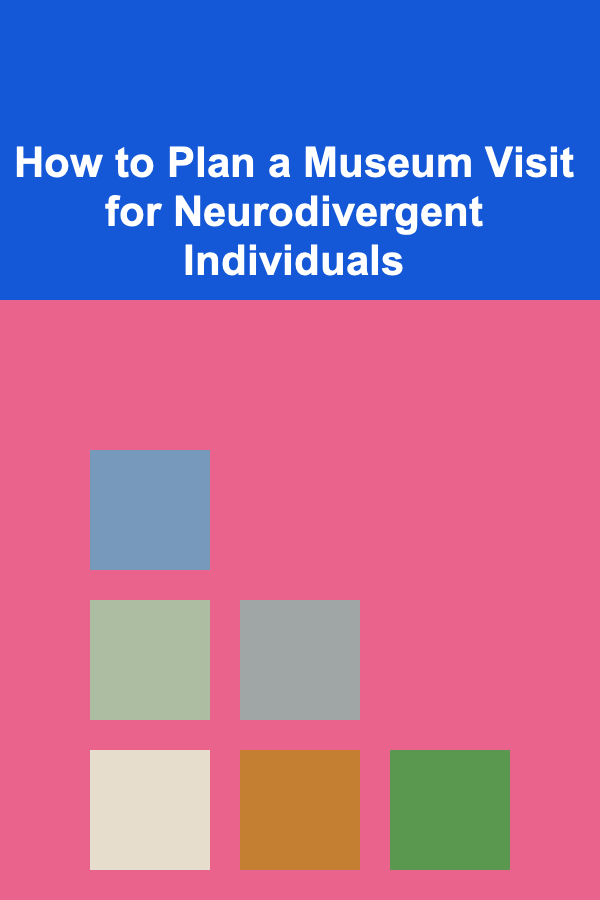
How to Plan a Museum Visit for Neurodivergent Individuals
ebook include PDF & Audio bundle (Micro Guide)
$12.99$9.99
Limited Time Offer! Order within the next:

Visiting a museum can be an enriching experience for everyone, but for neurodivergent individuals, the sensory overload and social demands associated with museum visits can sometimes be overwhelming. Neurodivergence includes a variety of conditions, such as autism spectrum disorder (ASD), ADHD, sensory processing disorders, and other cognitive or neurological differences that may require specific considerations. By planning thoughtfully, museums can become more accessible, enjoyable, and educational experiences for neurodivergent visitors.
This guide will provide practical tips and strategies for planning a museum visit that accommodates the needs of neurodivergent individuals, ensuring a positive and rewarding experience for all involved.
Understand Neurodivergence and Individual Needs
Each neurodivergent person experiences the world differently, and it's crucial to recognize that everyone's needs are unique. For example:
- Autism Spectrum Disorder (ASD) may involve sensory sensitivities, social communication challenges, and specific interests.
- Attention-Deficit/Hyperactivity Disorder (ADHD) might affect focus, impulse control, and the ability to filter distractions.
- Sensory Processing Disorder (SPD) means that a person may be overly sensitive to sounds, lights, or textures.
- Anxiety Disorders can make crowded spaces or unfamiliar situations feel overwhelming.
- Learning Disabilities may require specific accommodations to process information in a way that is meaningful.
Understanding the needs of the individual you are planning the visit for is the first step toward creating a successful museum experience. Talk to them or their caregivers to gain insights into their preferences and challenges.
Choose a Neurodivergent-Friendly Museum
Not all museums are equipped with the resources or accommodations that neurodivergent individuals might need. However, many museums are becoming more aware of the need to provide inclusive experiences. Look for museums that have specific programs or facilities designed to cater to neurodivergent visitors:
- Sensory-friendly hours: Many museums have designated times when they reduce noise levels, dim the lights, and limit the number of visitors to create a calmer atmosphere.
- Quiet spaces: Museums may provide designated quiet rooms or areas where visitors can retreat if they feel overwhelmed.
- Sensory tools: Some museums offer sensory kits that include noise-canceling headphones, fidget toys, or weighted blankets to help manage sensory overload.
- Accessible signage: Clear, simple, and visual signage helps those with processing difficulties or language barriers navigate the museum with ease.
Check the museum's website or call ahead to inquire about these accommodations. If you're unsure whether the museum provides these services, ask the staff about their inclusivity initiatives or any quiet hours they might have.
Prepare in Advance
Preparation is key to a successful museum visit, especially for neurodivergent individuals who might need additional structure and predictability. Here are some strategies to ensure a smooth experience:
- Visit the museum's website: Many museums provide detailed information about the exhibits, accessibility features, and any special programs. Familiarizing yourself with the layout of the museum beforehand can help you plan your route and understand what to expect.
- Create a visual schedule: A visual schedule outlining the key activities of the visit, including breaks, exhibits to see, and any social interactions, can help individuals know what to expect. You can create this schedule on paper, digitally, or using apps specifically designed for this purpose.
- Social stories: For those who might benefit from clear, step-by-step instructions on what to expect in unfamiliar environments, social stories are a great tool. These are short, individualized narratives that explain what will happen during the visit. They can be particularly helpful for children with ASD.
- Time considerations: Consider the timing of your visit. Avoid peak hours when the museum may be crowded or noisy. Some neurodivergent individuals may struggle in crowded, bustling environments, so quieter times, like weekday mornings or special quiet hours, are ideal.
- Plan for downtime: Museums can be overwhelming, so plan frequent breaks to avoid overstimulation. Research the availability of seating areas or quiet zones. Some individuals may benefit from taking short walks or resting in designated areas to recharge.
Choose the Right Exhibits
When planning a visit, it's important to choose exhibits that are both engaging and manageable for neurodivergent individuals. Some exhibits might be too noisy, crowded, or fast-paced, while others could be more calming or tailored to specific interests. Here's how to select the right exhibits:
- Interest-based exhibits: For individuals with specific interests (e.g., dinosaurs, trains, art), choose exhibits that align with their passions. This will not only make the experience more enjoyable but may also provide a sense of comfort in an otherwise unfamiliar setting.
- Interactive exhibits: Many museums offer hands-on exhibits that allow visitors to touch, manipulate, and explore. For neurodivergent individuals, interactive experiences can provide a more engaging and stimulating environment.
- Visual experiences: If sensory sensitivities are a concern, opt for exhibits that are visually appealing but not overwhelming. Avoid overly bright or flashing lights, loud sounds, or intense colors. Look for exhibits with a balance of visual elements, such as art galleries or historical displays.
- Avoid overstimulation: Some exhibits, especially those involving loud sounds, flashing lights, or overwhelming crowds, may be difficult for neurodivergent individuals to handle. If sensory overload is a concern, try to avoid these high-stimulation areas and choose quieter, more relaxed spaces.
It's helpful to create a rough itinerary of exhibits that you want to visit but be flexible in case the individual becomes overwhelmed and needs to adjust the plan.
Manage Sensory Overload
Sensory overload is one of the most common challenges faced by neurodivergent individuals in museums. The noise, crowds, lights, and visual stimuli can easily become overwhelming. Here are some ways to manage sensory input:
- Noise-canceling headphones: These can help block out background noise, especially in crowded areas or noisy exhibits. Some individuals may benefit from wearing them throughout the entire visit.
- Wearable comfort items: Items like weighted blankets or vests, fidget toys, or sensory gloves can provide comfort and help regulate sensory input.
- Dim or natural lighting: Bright, artificial lighting can cause discomfort for some individuals. Choose exhibits or museum areas that have softer or more natural lighting when possible.
- Frequent breaks: Plan for regular breaks where the individual can retreat to a quiet area, relax, and recharge. This can help manage sensory overload and prevent burnout.
- Comfortable clothing: Ensure that the individual is wearing comfortable clothing that doesn't cause sensory discomfort. Tags, seams, or fabrics that are too tight or scratchy can distract from the experience.
Provide Clear Expectations for Social Interaction
Museums often involve social interactions, whether it's speaking with staff members, interacting with other visitors, or participating in group activities. For neurodivergent individuals, these social demands can be challenging. To support their social needs:
- Prepare for social expectations: If the visit involves any structured group activities or interactions with staff or other visitors, prepare the individual for what to expect. For example, some museums may have guides that provide tours or encourage participation in group discussions.
- Role-play: Practice social interactions in advance. For instance, if the individual will be participating in a guided tour, it can be helpful to role-play the experience, so they feel more comfortable.
- Clear signage: Museums should provide clear, concise signage that indicates where visitors should go and how to interact with exhibits. For neurodivergent individuals, this clarity can reduce confusion and the stress of figuring out how to engage with displays.
- Respect for personal space: Some neurodivergent individuals may have a heightened sense of personal space. Be mindful of this during social interactions and remind others to respect boundaries.
Adapt to Individual Needs During the Visit
During the actual visit, it's essential to remain flexible and adjust to the individual's needs as they arise. Some strategies to ensure a smooth experience include:
- Frequent check-ins: Regularly check in with the individual to assess how they are feeling and whether they need a break, a change in pace, or a different type of support.
- Use of communication aids: For individuals who have difficulty communicating, use tools like picture boards, communication apps, or sign language to help them express their needs.
- Be patient and understanding: Museums are meant to be enjoyable, so if the individual becomes upset or overwhelmed, try to stay calm and offer reassurance. Sometimes, just taking a step back or leaving an overwhelming area can make all the difference.
- Allow for a flexible schedule: Don't feel pressured to stick to a strict timeline. Allow for changes to your plan based on how the individual is feeling.
Follow-Up After the Visit
Once the visit is over, take the time to reflect on the experience and gather feedback to improve future visits. Here's how you can support the individual after the museum trip:
- Discuss the visit: Talk about what they enjoyed, what they found overwhelming, and what could be improved next time. This feedback will help guide future museum trips and ensure that their needs are being met.
- Provide a calm transition: After a sensory-rich experience, a quiet time at home or in a calming environment can help the individual process the experience and unwind.
- Create a memory: For some neurodivergent individuals, it can be helpful to create a tangible memory of the visit, such as a scrapbook or photo album. This can provide a sense of accomplishment and help them revisit the experience in a positive light.
Conclusion
Planning a museum visit for neurodivergent individuals requires careful thought, flexibility, and understanding. By considering sensory needs, social expectations, and individual preferences, museums can be transformed into welcoming and enjoyable spaces for everyone. Preparation, clear expectations, and the right accommodations are key to ensuring that neurodivergent visitors can have a positive and enriching experience. Through thoughtful planning and empathy, museums can create an inclusive environment where all visitors feel valued, respected, and engaged.
Reading More From Our Other Websites
- [Personal Finance Management 101] How to Plan for Health-Related Expenses and Save for Them
- [Home Cleaning 101] How to Organize and Clean Your Closet Efficiently
- [Personal Financial Planning 101] How to Implement Wealth Management Strategies for Long-Term Financial Growth
- [Organization Tip 101] How to Use Carabiners and Clips for Quick Access Gear
- [Home Budget 101] How to Save Money on Groceries and Reduce Food Waste
- [Personal Financial Planning 101] How to Improve Your Credit Score in 90 Days
- [Personal Care Tips 101] How to Use a Facial Scrub Before Applying Makeup
- [Personal Finance Management 101] Best Resources for Learning Personal Finance Management Skills
- [Home Party Planning 101] How to Create a Memorable Home Party with Unique Themes and Finger Food Ideas
- [Home Staging 101] How to Showcase a Functional and Stylish Home Office Space

How to Clean and Disinfect Your Child's Playroom
Read More
How to Plan a Holiday Decorating Party with Friends
Read More
How to Understand the Role of Validators in Proof-of-Stake
Read More
Understanding and Managing Disordered Eating
Read More
Grasping the Principles of Level 1, 2, and 3 Charging for Electric Vehicles
Read MoreHow to Automate Your HSA Contribution Tracker
Read MoreOther Products

How to Clean and Disinfect Your Child's Playroom
Read More
How to Plan a Holiday Decorating Party with Friends
Read More
How to Understand the Role of Validators in Proof-of-Stake
Read More
Understanding and Managing Disordered Eating
Read More